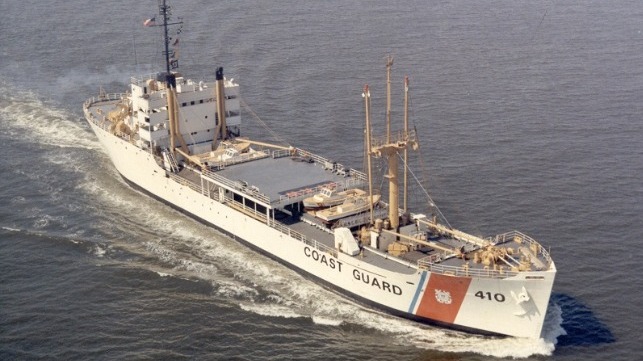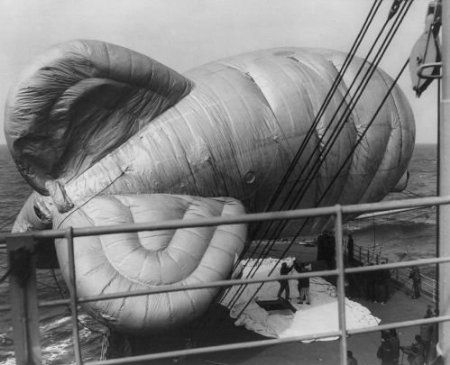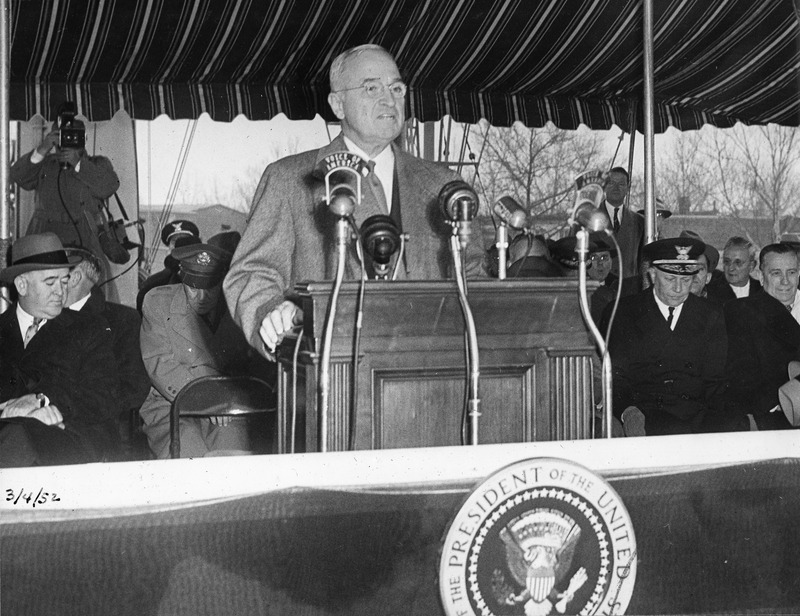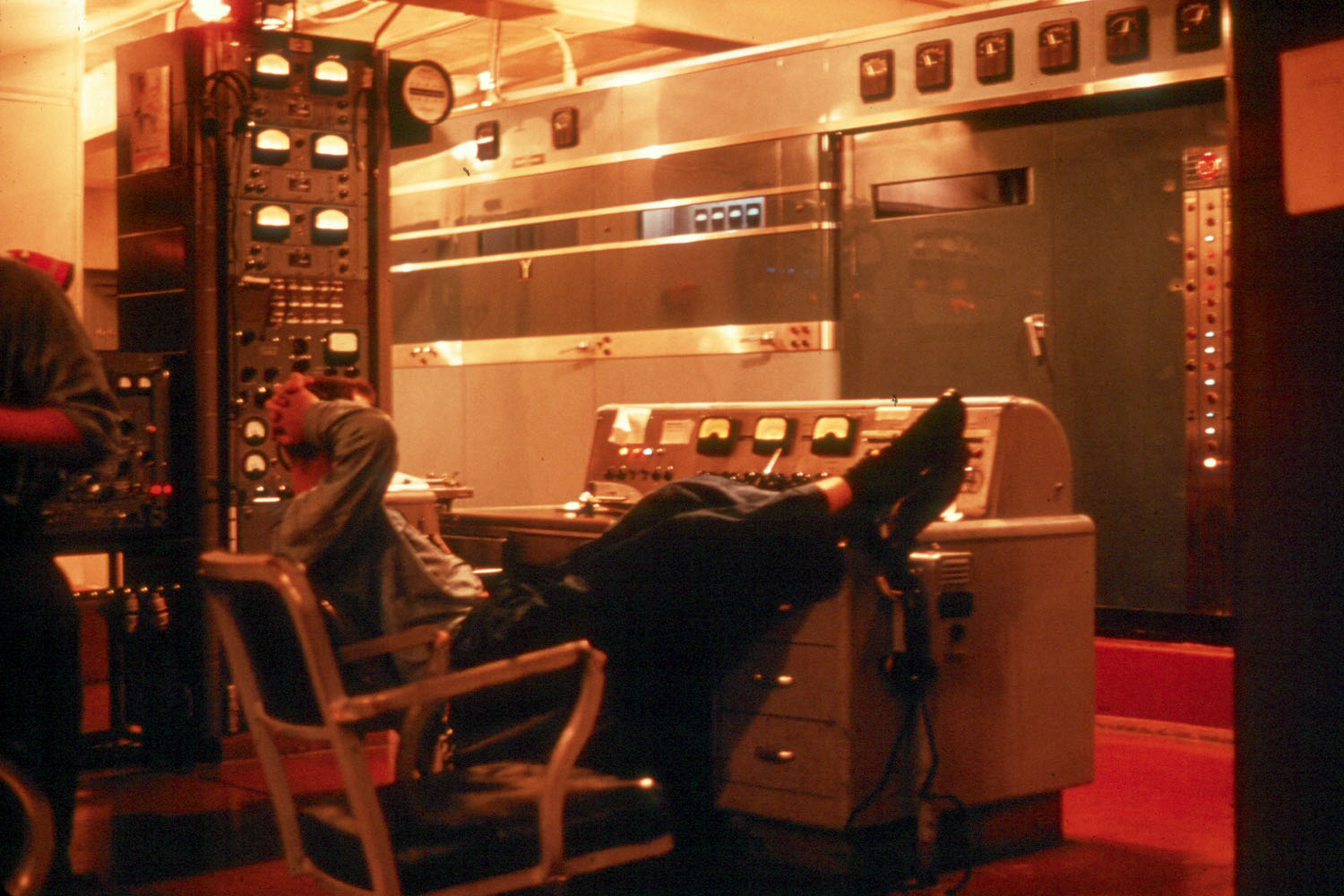Cold War Cutter Courier: A “Valiant Fighter in the Cause of Freedom”

[By Jennifer A. Gaudio, Aubrey Houck, and The Courier Association]
I am speaking to you today from a ship. It is a special kind of ship, and it will perform a very special mission. This vessel will not be armed with guns, or with any instruments of destruction. But it will be a valiant fighter in the cause of freedom. It will carry a precious cargo--and that cargo is truth. ~ President Harry S Truman, U.S. Coast Guard Cutter Courier, March 4, 1952
Antagonism between the United States and the Union of Soviet Socialist Republics (USSR) may be traced back to World War I and the Russian Revolution, when the U.S. refused to recognize the new Bolshevik government. After World War II, the relationship deteriorated into an icy sustained hostility that came to be known as the Cold War.

Courier’s antenna balloon, similar to the barrage balloons flown over potential military targets during World War II. (Crew of the Courier, Coast Guard Cutter Courier/VOA Association))
The Voice of America (VOA) began operation in 1942 as a radio program designed to explain U.S. policies during World War II. Its broadcasts were intended to bolster the morale of U.S. allies throughout Europe, Asia, the Middle East, and Africa. After the war, VOA became part of an American Cold War propaganda campaign. In 1947, it began broadcasting into the USSR. The first broadcast stated that its purpose was to give listeners a picture of life in America and broaden understanding and friendship between the Soviet and American peoples. Broadcasts consisted of news stories, human-interest features, and music.
The U.S. State Department officials released a news statement about the USSR using 1,000 jamming devices Sept. 5, 1950, Despite the practice of “cuddling,” broadcasting close to Soviet frequencies to deceive them into jamming their own programs, it was believed that only 30 percent of VOA segments were getting through. As a result, the State Department created a plan to penetrate the Iron Curtain by expanding VOA radio transmissions. Six high-powered shortwave transmitters on the east and west coasts of the U.S. would be linked with an overseas network of 14 one-megawatt relay bases, forming a ring around the Soviet Union.
President Harry Truman included the ring of transmitters in his “Campaign of Truth” speech delivered in April 1950. Congress approved $41.2 million as startup funds, however, after the November election, Congress drastically reduced the funding. Budget constraints cut the number of planned sea-based VOA transmitters from six to one.

Coast Guard Cutter Courier President Harry S Truman delivers his March 1952 “Voice of America Address” from the deck of the Courier moored in Washington, D.C. (Truman Presidential Library
The only transmitting ship commissioned was the Coast Guard’s Courier and it became one-of-a-kind. A Navy ship was first considered for the radio-broadcasting platform, but U.S. Navy vessels would pose a military threat by their presence. By making the ship an unarmed Coast Guard cutter, and by having it staffed and operated by Coast Guardsmen, the State Department ensured there would be no military threat to any nation. On March 4, 1952, President Truman dedicated the ship in Washington, D.C. Broadcast worldwide from the deck of Courier, Truman delivered “The Voice of America Address,” stating:
“This ship is named the Courier. It is well named, for it will be carrying a message. It will be carrying a message of hope and friendship to all those who are oppressed by tyranny; it will be carrying a message of truth and light to those who are confused by the storm of falsehood that the Communists have loosed upon the world.”
In summer 1952, the Courier set sail for Rhodes, Greece, in the southeast Aegean Sea. As a joint effort of the State Department, the Voice of America and Coast Guard, Courier was outfitted with radio transmitting abilities powerful enough to break through the Iron Curtain to citizens of Eastern Bloc countries. The ship arrived in Rhodes Aug. 22, and began broadcasting Sept. 7.
Courier’s Broadcasts
Courier’s RCA transmitter was used to broadcast VOA programming on the standard AM broadcast band, typically in the evening and nighttime hours at a frequency of 1259 KHZ. Its 150 KW output was three times that of the 50 KW output allowed for powerful AM broadcast stations in the U.S. Courier’s AM band also allowed VOA programming to reach audiences in the Middle East and southern Soviet Union. The transmitter’s original barrage balloon antenna was later replaced with an “inverted delta” antenna designed by a VOA engineer.

A Coast Guard Cutter Courier electronics technician stands, or perhaps sits, the watch at the controls of the massive 150,000-watt RCA transmitter. (Crew of the Courier, Coast Guard Cutter Courier/VOA Association))
VOA programs consisted of music, news, and commentary and came to Courier by shortwave transmissions from VOA sites in the U.S. Courier was equipped with shortwave receiving antennas located on its stern, but those antennas and their receivers performed poorly due the high radio frequency energy emitted by Courier’s transmitters. An attempt to shield the receiver antennas with a Faraday Shield (known as the “Bird Cage”) on the ship’s stern did not help. Thus, the Courier had to depend on a land-based receiving site located on the island of Rhodes to receive VOA Programming from the U.S. and relay it to the ship via a short-range VHF radio link. The first receiving site was on Monte Smith, a hill overlooking the town of Rhodes. An improved receiving site with better antennas in Koskinou replaced the Monte Smith site in the later years of Courier’s assignment.
Many of Courier’s crew worked rotating shifts of three sections, seven days on and one day off. Reporting for duty was not always easy. Frequently, ocean conditions required the ship to anchor offshore and, because few telephones existed on the island, a crewmember might not know where the ship was until he arrived at the harbor.
With evening watch, a sailor had to be at the dock no later than 3:30 p.m., to catch the liberty boat. The morning could be spent sleeping in and exploring the island before reporting for duty. Getting off duty at midnight still allowed time to visit a taverna, usually Bamboola’s, where good food and beer could be found for a good price.
Night watch was a sleep-deprived shift with crewmembers arriving at the cutter around 11:00 p.m. Sleep was difficult during the day because of noise from the city. Often, a crewmember was lucky to get two hours sleep before the city came alive.
Part of the Family
With no military base or strictly American neighborhoods, crewmembers and their families rented homes owned by members of the local community. Nannies and other domestic help were hired from a pool of young Rhodian women, usually single, with no families of their own. American and Rhodian children played together while mothers socialized, shared recipes and visited the market to find the best bargains. This allowed Coast Guard families to learn the Greek language by natural immersion.
The connection between Courier’s crew and the Greek community in Rhodes was an important part of the Courier’s mission as a broadcasting outlet for the VOA. Having the families of the Courier crewmembers live in the local community was one important aspect of that effort. Providing an outlet for the single crewmembers who lived aboard the ship was another requirement that had to be met. The Courier’s first commanding officer, Capt. Oscar Wev, arranged a “mixer” party for single crewmembers at the Hotel De Roses, an elegant venue built by the Italians during their occupation of the island. Mixer functions like these were very successful with 95 Rhodian “girls” marrying “Courier Boys.” These marriages were, and still are, proof of the strong Greek-American relationships established at the time.
Courier’s Legacy
The Courier was more than an outpost in the Cold War—it was a technological marvel. The Courier continued VOA relay broadcasting until 1964. That year, the transmitting equipment was transferred to a permanent land-based site and the cutter returned to the U.S. for decommissioning on Aug. 25. Courier was turned over to the Coast Guard Reserve Training Center at Yorktown, Virginia, and re-commissioned in 1966 as a training vessel. At Yorktown, it provided both dockside training in merchant marine safety and dangerous cargo handling, and at-sea training for Coast Guard reservists until decommissioning in 1972.
The Coast Guard Cutter Courier was successful in its mission to bring a voice of hope and freedom to the world. It upheld the humanitarian mission of the Coast Guard. In addition, its crew became part of the community and helped rebuild the economic and cultural structure of a Greek island that had been decimated by World War II.
Jennifer A. Gaudio is the curator of the Coast Guard Academy Museum and Aubrey Houck is an intern at the Academy Museum.
This article appears courtesy of The Long Blue Line and appears here in an abbreviated form. It may be found in its original form here.
The opinions expressed herein are the author's and not necessarily those of The Maritime Executive.
